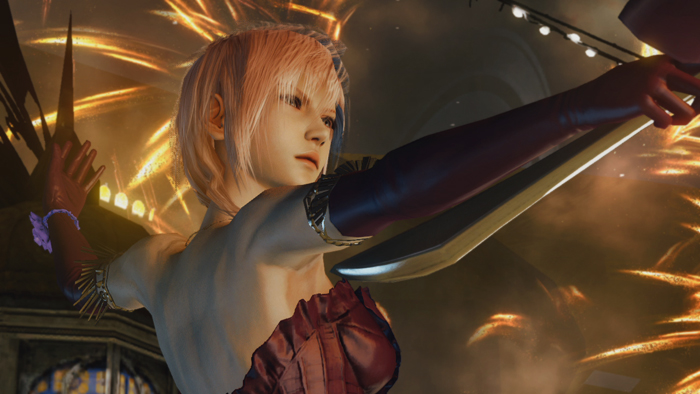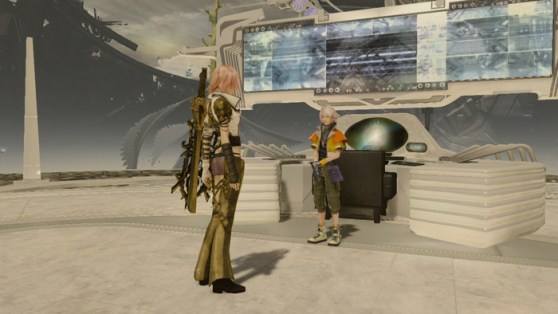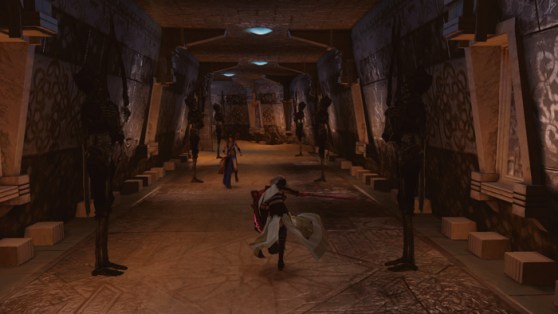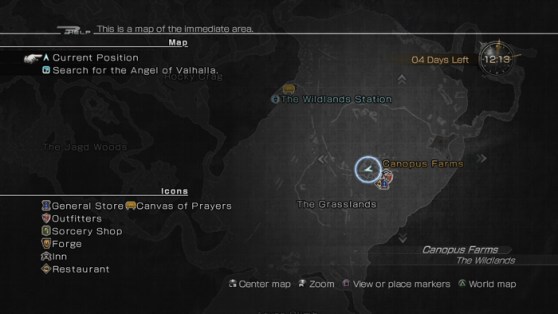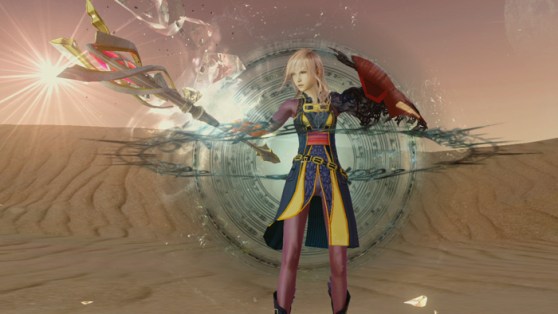What you won’t like
A story dumped on your lap entirely through exposition
The benefits of having a universe with complicated internal mythologies and cultural nuance vaporize when you need to spoon feed everything within that universe to your audience. Lightning Returns may set a new record for the most exposition-dense conversations ever in a video game, both overall and in EPM (explanations per minute, a rate I just made up).
Having characters speak in “As you already know…” monologues is one thing, but then having the other person in the conversation rephrase the exact same thing with just as little emotion is an entirely new form of tripping over oneself. The conversations between Lightning and Hope (a returning Final Fantasy XIII and XIII-2 cast member repurposed as God’s eyes and ears) are particularly grating. Not only is each of your 13 days bookended by drawn out bits of the characters effectively reading from the in-game dictionary, but Hope acts as a horrifying mix of Metal Gear Solid’s Otacon and The Legend of Zelda: Ocarina of Time’s Navi while Lightning is out soul-collecting.
Whatever interesting world-building that goes on during quests is ruined when Hope pipes up via God Bluetooth to tell Lightning exactly where to go, what to do, and who to speak to, all before repeating the last 30 seconds of NPC dialogue. It doesn’t matter that the game’s four main locations are sprawling swathes of land open for exploration; Square still doesn’t trust players to know what to do with their limited time.
The result is more disheartening than aggravating. Lightning Returns is teasing us with some heavy material: global immortal ennui, the unbelievable pressures of being a savior, and a capital “g” God preparing to end it all. But it all throws up on itself almost instantly with unnecessarily dense dialogue from characters that sound like they’d rather be anywhere else. The story provides a reason for why Lightning is genuinely stripped of emotion, but that doesn’t make spending dozens of hours with her any more bearable. It manages to scrape together enough emotional attachment for one hell of a finale (and the character of Lumina is an entertaining mix of bubbly preteen and potential spawn of evil), but it is nowhere near enough to counteract the drudgery.
A world of wasted space and confusing mazes
Places come in two flavors in Lightning Returns: needlessly open and frustratingly dense. The two urban spaces, Luxerion and Yusnaan, fare well enough thanks to the aforementioned art direction. But the plains of the Wildlands and the Dead Dunes desert contain both gratuitously stretched out center areas and frustratingly convoluted winding roads.
The Dead Dunes is the worse of the two, with an underground dungeon of time-locked doors that force you to constantly be opening and closing the menu screen in confusion. It, alongside the Wildlands’ intersecting forests, was designed more to waste time than anything else. These areas have been purposefully laid out to consume as much of your 13 days as possible, and they funnel more than a few unwanted monster encounters directly into your face. You can manage to avoid repeating the time sink by activating teleport locations, but you’ll be so burnt out with these locations that you’ll rarely want to (or need to) return.
A new kind of forced grinding
Thirteen days doesn’t feel like a long time, but Lightning Returns will have you making the most of it, and not always in a good way. It ties progression to quests, not battle victories. Everything from fetch quests — listed on a Prayer Board next to an annoying woman in a Chocobo outfit — to the five main quests net gains in health, magic, strength and EP slots (Lightning’s special savior abilities that enable her to slow down time, deal massive damage, or instantly teleport around the world map). Stronger abilities and higher-ranked spells may also appear as rewards at the end of the more involved quests.
This means that if you want to be in any condition to complete the more difficult missions, let alone the end game, these optional side objectives just became mandatory. Thankfully, you can achieve most of the minor quests en route to larger objectives, but be prepared to find thing X (usually by defeating monster Y) to give to person Z more times than you’ll be comfortable with. It doesn’t help that many quests are time-locked and specific to one of the four regions, forcing either a lot of wasted time on trains or precious EP spent on instant transportation.
Conclusion
Lightning Returns: Final Fantasy XIII has enough to engage you that you will care about how much better it all could have been. The art design tells a much stronger story than the text boxes disguised as characters, but you’ll be far too busy finding and swapping your new favorite Schemata to care. This is the most satisfying battle system the series has had since Final Fantasy X, and it stands strong enough on its own to merit a recommendation for most players.
But if that’s not enough for you, don’t worry. It’s not the end of the world.
Score: 65/100
Lightning Returns: Final Fantasy XIII releases on Xbox 360 and PlayStation 3 on Feb. 11, 2014. The publisher provided GamesBeat with a prerelease PS3 copy for the purposes of this review.
VentureBeat's mission is to be a digital town square for technical decision-makers to gain knowledge about transformative enterprise technology and transact. Learn More
